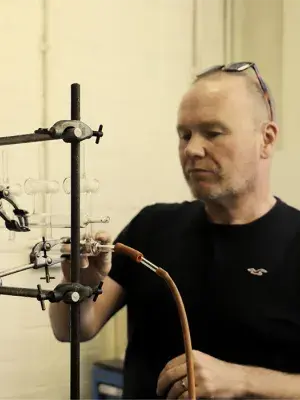I am the glassblower here at the University. I make glassware for many people, mainly for research students in Chemistry. Essentially, I make glassware that you can’t buy, I don’t make standardised equipment like beakers or test tubes. Usually, students come to me with their own design of a scientific apparatus, and we will discuss the design and I’ll make it for them. A typical working day of mine goes like this: when I arrive at the workshop, first I check if any glassware had broken over the night. Then, I would check if the oven overheated— when it does sometimes, it could ruin everything you’ve made in the previous day, and you don’t want that. After this, I get some little jobs done, like repairing things. Finally, I get on with the big pieces.
Stuart is the only scientific glassblower at the University of Edinburgh, he is based at the School of Chemistry. Every day, he designs, makes, and repairs scientific glassware for students and staff in his workshop. Stuart handles glass with sophisticated skill; he has been a glassblower for over three decades and even spread his knowledge to Sri Lanka. Stuart hopes to keep the traditional skills alive in the glassblowing industry.
My job
How I trained
I’ve been glassblowing since I was 16 years old. I know a lot of people these days have had many different jobs, and they’ve had so many different experiences, but it is not the case for me. I’ve been glassblowing my whole life, I love what I do, and I don’t know where I would be without it. Around 1988, I got a traineeship in Glasgow to practice glassblowing. In the beginning, I was simply looking for something to do, I was young and didn’t have anything that I wanted in particular. I came across a university in Glasgow, where they were taking in a lot of trainees to cover different positions, so I went there. Glassblowing was the position that was assigned to me. Going to work every day was scary at 16 years old. I had to take a train, a bus, and a tube— I probably hadn’t been in the city for more than three times before this. When I arrive at the workshop, I and other apprentices would work for more than eight hours every day. My boss was a taskmaster, a rigid man who was extremely good at what he did. He used to tell us stories of his boss in the 60s, who was even more strict. In the first three years, everything that we made went into the bin, because we wouldn’t allow bad glassware to go into the system, they had to be perfect to sustain extreme conditions like vacuum and pressure. I spent seven years of my life in Glasgow practicing glassblowing, and I can tell you seven years of apprenticeship is not an easy thing to do, it was hard when you couldn’t see improvements on a day-to-day basis. However, if you keep going, one day, your hands just suddenly understand what to do.

Joining the University
I joined the University in 1995. Back then, glassblowing was more spontaneous, we made crazy stuff. We used to have huge vacuum systems set up on the wall for ‘mad’ scientists to do experiments on— big glass tubes and different flasks— like something that you’d see in Frankenstein films. My favourite thing was building big glassware. I remember having to build small sections first and assemble them all together inside the room. Now that 27 years have passed, everything had become more standardised, each student gets a small equipment kit that is efficient enough to support many types of complex experiments.
Sri Lanka
The most interesting thing that I’ve done throughout my 27 years of career at the University was probably bringing my glassblowing skills to Sri Lanka. It started just before I joined the University. There was no glassblowing in Sri Lanka back in the 90s; they had some equipment from the 60s and the 70s, but no proper skills, so a guy was sent to the UK to learn the techniques from us. The apprentice stayed with us for six months and returned to Sri Lanka to set up his own workshop. Two years later, he came back to me to learn more. Since then, we’ve been making trips to each other’s countries, bringing as many glassblowing skills as possible to Sri Lanka. When I was back there in 2020, there was a class of 16 people at the workshop, with a few boys selected as potential glassblowers in the future. However, when COVID-19 happened, it made things difficult for them. Although it is still hard, the situation is slowly recovering now. I hope that these people will make successful glassblowers one day.
Glassblowing today
Now, in 2023, there are only about 6 glassblowers left in Scotland. Not many people are aware of our existence; and most of the time, they don’t think about where a piece of glassware came from when they look at it. In chemistry labs, they see a box of broken scientific glassware disappear and come back fixed, and they probably don’t think about how. In fact, there are plenty of people who work in the same department as me but don’t know that I’m here. But I don’t really blame them. I’m only worried that we’re slowly losing continuity in this specialised industry due to the lack of awareness of what we do. My biggest plan right now is to look for a trainee to take in for when I retire. It won’t be too easy for both of us. Firstly, becoming a glassblower certainly takes a lot of persistence and determination. Secondly, it requires the same efforts from me to train one. It’s a long process but I believe the history and meaning of the beautiful practice are undoubtedly worth it. Let glassblowing live on!
This article was published on

